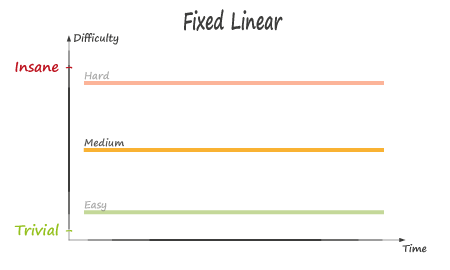Trending
Opinion: How will Project 2025 impact game developers?
The Heritage Foundation's manifesto for the possible next administration could do great harm to many, including large portions of the game development community.

Featured Blog | This community-written post highlights the best of what the game industry has to offer. Read more like it on the Game Developer Blogs or learn how to Submit Your Own Blog Post
The design of the difficulty curve is important to most games. This post provides a short, illustrated look at a handful of different difficulty curves a game designer can shape the challenge progression after.

In my first Gamasutra blog post, I will look at a critically important element in game design: The design of the difficulty curve.
There are surprisingly many ways, the difficulty can develop througout a game. Any curve has its own strengths and weaknesses, and there is no perfect curve that fits every game. Here I will look at the most regularly used curves:

Fixed Linear
This is the most basic curve. There is no change in challenge over time, but you can have different levels of difficulty.
Pros:
Easy to control.
Cons:
Gets boring quickly (because the player's skill evolves).

Fixed Increasing Linear
The main problem with the previous curve, is that the player doesn't really need to improve his skills, over the course of the game. This curve address that, by letting the difficulty increase, as the player progresses through the game. Note: I have only added the medium curve in the illustration - that is just me being lazy. Having multiple levels of difficulty is always possible.
Fixed Increasing Wave
To keep things interesting a bit longer, you can change the curve to some kind of waveform (a sine, or perhaps a triangle wave as illustrated here). You still know the exact difficulty at any point in the game, but the oscillation of the curve, feels slightly more interesting to the player.
Fixed Logarithmic Wave
The problem we solve with this curve, is the impossible difficulty the previous curve could end up with. A logarithmic curve increases towards some maximum, and then stays there.
Interval Wave
To make the challenges more difficult to predict, the game can randomly pick a level of difficulty within a defined interval, instead of following a fixed curve. Instead, the interval range should follow a curve.
Interval Widening Wave
An easy introduction is often a good idea. A Fixed Logarithmic Wave gave us that, but with an Interval Wave we don't have precise control of the initial difficulty. One way to solve that, is to start with a narrow interval and widen it up over time.
Interval Logarithmic Widening Wave
Using a logarithmic curve, we can have both the initial widening of the Interval Widening Wave, and allow the diffuculty to convergence towards some maximum. We also need to limit the widening over time, to prevent extreme oscillations in difficulty.
Pros:
Controlled, but still gives a nicely alternating difficulty level.
Cons:
Might be too uncontrolled (use Fixed curves then).
Conclusion
I presented several different curves. They are easily divided into two catogories: Fixed curves and Interval curves. I introduced Interval waves last, because they are more complex - not because they are always better. Often, there is no need to use Interval curves. You might want a more controlled experience, or maybe the random factors involved in using an Interval curve, doesn't work well with your game mechanics. The testing and balancing of an Interval curve is often quite time consuming as well. The terminology I'm using is my own by the way - I have not found much writting on this subject.
Another area of interest, is adaptive difficulty - letting the difficulty depend on measured player skill. Adaptive difficulty is indeed used in some games, but extreme care needs to be taken to prevent players from exploiting it. Such a system often allows a player to play bad on purpose, letting him complete the game more easily. I'm still looking for perfect solution to this problem.
Of course, one can also imagine a game where the fun doesn't come from the challenge at all. Collection, gambling, humor - there are lots of fun game design elements, one can use besides challenges. Even so, challenge is the most traditional kind of fun in games, and the design of the difficulty curve is extremely important in most games.
Finally, it is worth noting that I skipped several curves here. One could imagine for instance an Interval Logarithmic Widening Linear curve, which would look like the Interval Logarithmic Widening Wave except for the wave shape. The practical difference, would be the lack of the planned drops in difficulty a Wave curve provides. There are other missing curves as well, and of course there are also more complex, manually tuned curves made to fit for instance a three-stage plot structure.
Read more about:
Featured BlogsYou May Also Like